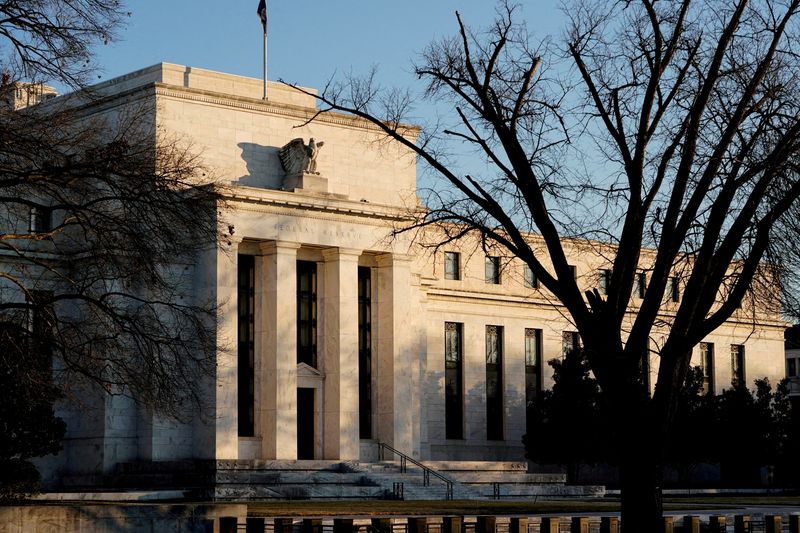LONDON (Reuters) - Major central banks are racing to ditch post-pandemic stimulus and picking up the pace of interest rate hikes to get on top of surging inflation.
The Reserve Bank of Australia on Tuesday became the latest to deliver a hawkish surprise with a half-point rate hike, following in the footsteps of the United States, Canada and New Zealand.
And the more cautious European Central Bank on Thursday ended a long-running stimulus scheme and signalled a series of rate hikes.
Here's where policymakers stand on the path out of the pandemic-era stimulus, ranked in terms of hawkishness.
Graphic: Rate hike checklist - https://graphics.reuters.com/GLOBAL-CENTRALBANKS/zdvxowbjbpx/chart.png
1) NORWAY
Norway's Norges Bank was the big developed economy to kick off a rate-hiking cycle last year and has raised rates three times since September. It is expected to increase its 0.75% rate again on June 23 and plans seven more moves by end-2023.
Graphic: Most major central banks are hiking interest rates - https://fingfx.thomsonreuters.com/gfx/mkt/gdvzyeljxpw/RATES0706.PNG
2) NEW ZEALAND
The Reserve Bank of New Zealand is also one of the world's most hawkish central banks, raising the official cash rate by 50 basis points (bps) to 2% on May 25, a level not seen since 2016. That was its fifth straight rate hike.
It projected rates to double to 4% over the coming year and stay there until 2024. New Zealand inflation reached a three-decade high of 6.9% in the year to Q1, versus a 1-3% target.
Graphic: New Zealand among the most aggressive central banks - https://fingfx.thomsonreuters.com/gfx/mkt/jnvwezdkqvw/NZ0706.PNG
3) CANADA
The Bank of Canada delivered a second consecutive 50-bps rate increase to 1.5% on June 1, and said it would "act more forcefully" if needed.
With April inflation at 6.8%, Governor Tiff Macklem has not ruled out a 75-bps or larger increase and says rates could go above the 2%-3% neutral range for a period.
Deputy BoC governor Paul Beaudry has warned of "galloping" inflation and markets price an unprecedented third consecutive 50-bps increase in July.
4) BRITAIN
The Bank of England has raised rates four times since December, including last month's quarter-point move. Its 1% key rate is at the highest since 2009.
Another rate hike is anticipated on June 16 and markets see rates ending 2022 above 2%. But Britain's deteriorating economic outlook is making some policymakers cautious.
Graphic: UK inflation is at a 40-year high - https://fingfx.thomsonreuters.com/gfx/mkt/zgpomexlwpd/UK0706.PNG
5) UNITED STATES
The Federal Reserve is set for half-point rate increases in June, July, and perhaps even beyond as jobs data show no sign the U.S. economy is buckling under high inflation and rising borrowing costs.
The key Fed funds rate is expected to rise to a 1.25%-1.50% range on June 15 and markets see it going to 2.75%-3% by year-end.
The Fed is also reducing its $9 trillion stash of assets accumulated during the pandemic.
Graphic: Central bank balance sheets are starting to shrink -- slowly - https://fingfx.thomsonreuters.com/gfx/mkt/akvezrwyzpr/balancesheets070622.PNG
6) AUSTRALIA
With the economy recovering smartly and inflation at a 20-year high of 5.1%, the Reserve Bank of Australia raised rates by a surprise 50 bps on June 6. It was the RBA's second straight move after insisting for months policy tightening was way off.
Money markets now price in chances of another 50 bps rise in July and see the current 0.85% rate touching 1.5% by August.
7) SWEDEN
A late-comer to the inflation battle, Sweden's Riksbank raised rates to 0.25% in April in a quarter-point move. With inflation at 6.4%, versus its 2% target, the Riksbank may now opt for bigger moves.
Having said as recently as February that rates would not rise until 2024, the Riksbank expects to hike two or three more times this year.
8) EURO ZONE
Record-high 8.1% inflation has turned the dovish European Central Bank into a hawk.
It said on Thursday that bond buys will end on July 1, rates will rise by 25 bps later that month and again in September. It last lifted rates in 2011.
Markets moved to price in 143 bps of tightening by the end of this year versus 138 bps before the ECB statement, meaning the key -0.50% deposit rate is set to exit negative territory soon.
Graphic: Euro zone inflation is at record highs - https://fingfx.thomsonreuters.com/gfx/mkt/egpbkwxeovq/ecb0706.PNG
9) SWITZERLAND
The Swiss National Bank is under pressure to raise its -0.75% interest rate, the world's lowest. Inflation is approaching 14-year highs at 2.9% and price rises have been outside the SNB's annual 0%-2% target range since February.
SNB officials insist the inflation surge is temporary. But rate-setter Andrea Maechler reckons the SNB will "not hesitate" to tighten policy if inflation rates remain stubbornly high, shining a spotlight on the SNB's June 16 meeting.
10) JAPAN
That leaves the Bank of Japan as the holdout dove.
BOJ boss Haruhiko Kuroda says the top priority is to support the economy, stressing unwavering commitment to maintaining "powerful" monetary stimulus.

Japan's core consumer prices in April rose 2.1% from a year earlier, exceeding the BOJ's 2% target for the first time in seven years. Still, BOJ officials have repeatedly stressed that such cost-push inflation will prove temporary and won't prompt a tighter monetary policy.
Graphic: BOJ and JP CPI - https://fingfx.thomsonreuters.com/gfx/mkt/dwvkrnbyjpm/BOJ%20and%20JP%20CPI.JPG